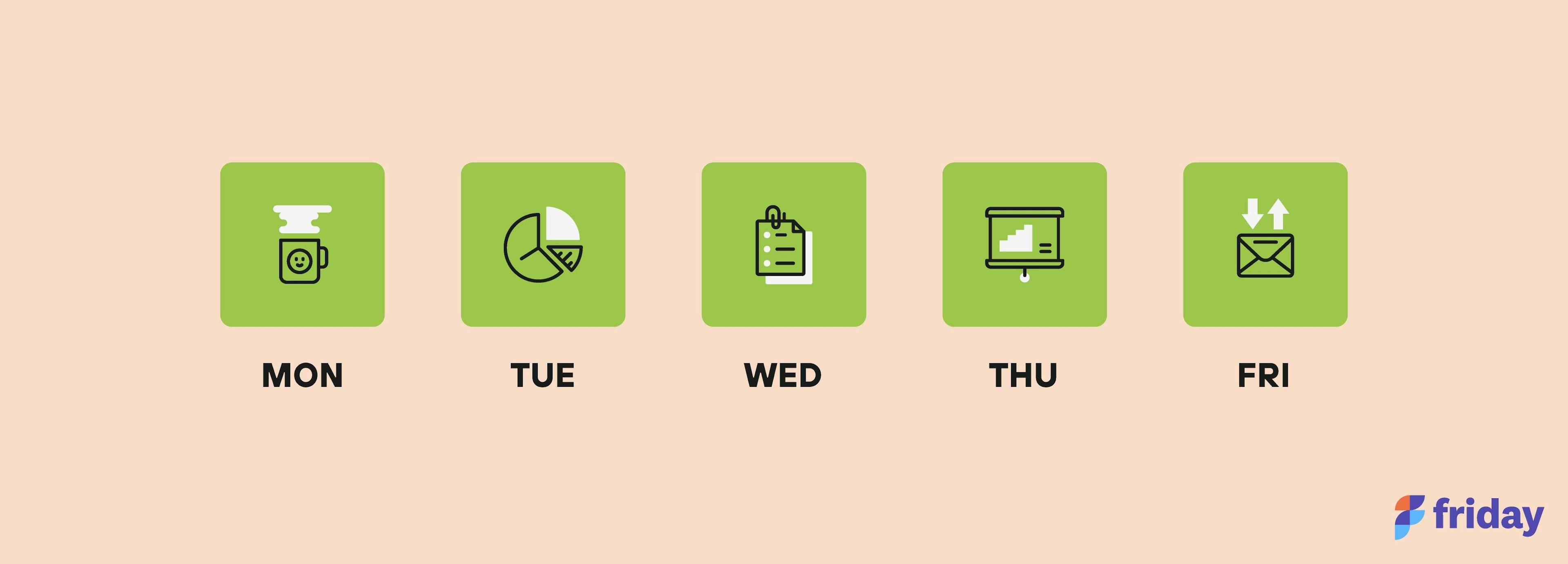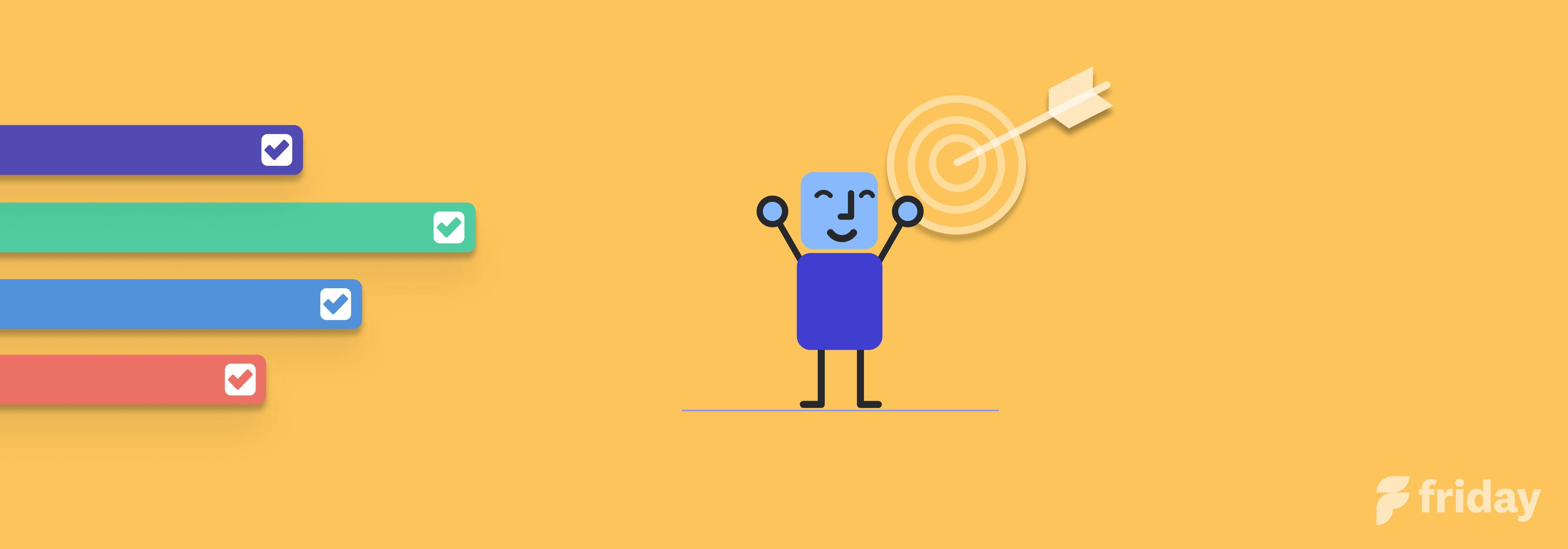How To Have A Productive Week: 10 Tried and Tested Tips

It's Monday morning. You’re ready to start working. Your laptop is charged. Your coffee is ready. You’re pumped. Everything’s on track.
But, before you start working, you decide to check your emails. "Just for a second," you tell yourself.
Then while you’re on it, you quickly open LinkedIn to go through all the recent updates.
And before you know it, 2 hours have passed and you have yet to start working.
This has been happening every single day. As soon as you sit down to work, your inner procrastinator urges you to do everything apart from work.
Your to-do list is increasing. Your work’s piling up. The more your work piles up, the more you end up procrastinating. It’s a never ending cycle where your bad work habits are stopping you from being productive.
So frustrating.
A recent study found that more than 90% of adult Americans spend 15-18 hours/month on Facebook. That’s almost 2 full work days spent every month mindlessly surfing on social media.
How Should You Plan Your Week To Be Productive? Top Productivity Tips
So how should you plan your week to be more productive, to make sure you do everything you’ve set out to do?
1. Focus on a single task.
There, I’ve said it.
When work piles up, our brain urges us to tackle multiple tasks at once.
But instead of helping us complete all the tasks, our productivity goes down by as much as 40%. And research also shows that serial multitaskers are less competent at tackling tasks than ones that do it infrequently. So the more you try to multitask, the worse you’ll be at it.
Solution?
Focus on one task at a time.
Even if you have a plethora of tasks demanding your attention, start by focusing on one thing and complete that before moving on to the next.
2. Optimize how you work
Maximize your efficiency by optimizing how you work. This includes not just automating mundane tasks and avoiding micromanaging, but also creating an optimum work environment for yourself.
If you're working remotely, create an office space in your home. If you don’t have space, find a cafe or a co-working space where you can go and work. Keep your workspace clean and decluttered. Use a calendar to manage your work. Create achievable to-do lists. Make sure you have all the right tools, equipment and resources at your disposal.
Another way of optimizing how you work is by bundling similar activities together.
Regina Barr, Founder & CEO of Red Ladder, Inc. explains, “On a daily basis, I try to bundle like activities together and have a focus area for each day. Monday (marketing), Tuesday (touchbase), Wednesday (writing), Thursday (team) and Friday (finance). I communicate this to my team members so that they can schedule accordingly. This does not mean that I don't work on these items other days of the week when necessary. It just provides a framework and structure to help me focus and work efficiently particularly when working with remote teams.”
3. Learn to say “no.”
You’re juggling a dozen projects and suddenly your boss hands you another project.
What do you do?
Do you feel obliged to accept? Or do you politely refuse because it's not humanly possible for you to take on yet another project?
Being productive starts with learning to say no to anything that isn’t a priority for you and doesn’t help you accomplish your goals. As Warren Buffet says, “The difference between successful people and really successful people is that really successful people say no to almost everything.”
However, learning to say no politely is an art that not many have mastered. Some ways you can say no without upsetting others include,
- Embrace the silence. Yes, silence can get a little awkward at times, but it gives you the opportunity to think before you answer. Can you really attend that meeting or take on another project? Think before you give an answer.
- Offer alternatives. Instead saying an outright no, give people alternatives. You can’t attend the meeting, but do you know someone else who can attend it on your behalf? Can you do a short phone call?
- Set expectations in advance. Swamped with work? Let your manager know in advance.
- Don’t be vague. If you can’t do something, firmly and explicitly state that you can’t do it. Don’t make half-hearted promises like “I’ll see.” Think about how you can update your boss in a helpful way.
4. Begin your day with movement
Lori Cheek of Cheekd believes in starting everyday with some sort of movement.
She shares, “I have a morning routine that helps my work productivity. As soon as I wake up around 5:30 am, I start the coffee maker then I roll out my yoga mat and do 30 pushups, 100 sit-ups and 3 rounds of one minute planks followed by a quick stretch. It takes less than 20 minutes and not only does it get my heart pumping and immediately wake me up, it gives me a calm start to the day.”
A recent study found that exercise not just only improves well-being, but participants noted a 72 percent improvement in time management and workload completed on days when they exercised.
5. Make smaller goals
Instead of trying to tackle everything in one go, try to cut down your tasks into smaller, realistic goals. Smaller goals are easier to achieve. They make the entire process a lot less stressful.
Before sitting down to work, make a list of tasks you need to complete. Choose the first task and then break it down into smaller, easily achievable tasks.
Break down your upcoming week by days, and your work days by the hour. A productive day leads to a productive week.
Ashley Mason, CEO of a multi-6-figure marketing agency Dash of Social, is a big believer of breaking down her day by the hour to get more done.
Mason explains, “As tedious as it sounds, I write out my to-do list each day by the hour. This helps me to REALLY stay on track, and I love being able to cross things off once I finish them. It's also really helpful for ensuring things get done on the day that they need to be.”
6. Complete is better than perfect.
Don’t strive for perfection at first go. Strive for completion.
Once a task is completed, it can alway be perfected. But a blank canvas cannot be perfected.
7. Block distractions
The best way to practice single tasking is by blocking out all distraction. Social media websites, email, slack notifications, and even Netflix (because we all know we’re not going to stop at just one episode!).
Use Focus Time, Friday’s Chrome extension, when working on your laptop. It helps to block out websites that you don’t want to waste time on while working.
8. Automate repetitive tasks
Automation basically puts tedious, repetitive tasks on auto-pilot, so they’re being done even as you sleep. And tasks that can’t be automated, can always be outsourced.
Some tasks that can easily be automated are:
- Sorting emails according to keyword and sender. Did you know, on average, workers receive 200 emails each day and spend two and a half hours reading and replying to those emails? You can further create email templates for emails that only require a ‘Sounds good’ kind of response.
- Proofreading your work. Tools like Grammarly and Hemmingway app help a lot with proofreading.
- Scheduling meetings.
- Weekly updates. Instead of manually writing to-do lists for the week, automate them. Keep on top of your weekly updates and see what’s on the agenda for the coming week through Friday.
Use the extra 30% of your freed up time on tasks that actually demand your time and attention.
Your time is precious, so don’t waste it working on mundane tasks that decrease motivation, replete energy, and cut into your productive time. This is also known as lean thinking - the process of organizing activities to increase productivity while eliminating waste.
So only do what you need to do. Everything else can be automated or outsourced.
9. Create a list of tasks to only do once during the workday
What tasks do you spend the most time on?
Mindlessly scrolling on social media, chatting with people on Whatsapp, reading news, or going through emails?
Make a list of all the tasks that distract you while working and set a time once a day when you’ll do them.
10. Take short breaks frequently
Are you familiar with the Pomodoro technique?
It asks you to alternate focused work sessions with short breaks. So work for 25 minutes and then take a 5 min break. But keep a timer with you. A 5 minutes break means a 300 second break only. Not a 5 minutes turned into a 2 hour long break!
Does it work?
Absolutely. A lot of people swear by this method to combat procrastination, stave off mental fatigue, and promote continuous concentration.
Francesco Cirillo, founder of the Pomodoro technique, also suggests taking a longer 15 to 20 minutes break to reward yourself once you’ve successfully completed 4 pomodoros - 4 sessions of focused work.
You can use these Pomorodo timers and apps to help you.
How Can You Be More Productive in a Week?
Productivity doesn’t mean working 80 hour weeks. A Stanford study actually found that productivity declines per hour sharply when a person works more than 50 hours a week.
So it’s not a question of working more, it’s how you can increase your productivity and improve your time management skills.
- What productivity hacks can you religiously follow?
- How to get more out of the hours you’re working?
- How to plan the coming week in a way that you get more done?
- How to create systems that allow you to increase your efficiency and productivity?
So instead of working more, try to work smarter on important things.


